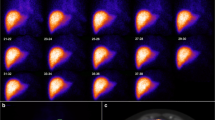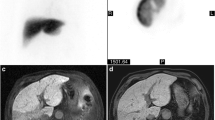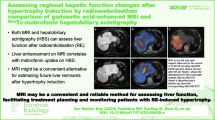Abstract
Objectives
To compare Gd-EOB-enhanced MRI and 99mTc-mebrofenin hepatobiliary scintigraphy (HBS) as imaging-based liver function tests for separate evaluation of right (RLL) and left liver lobe (LLL) function.
Methods
Fourteen patients underwent Gd-EOB-enhanced MRI and 99mTc-mebrofenin HBS after portal vein embolization within 24 h. Relative enhancement (RE) and hepatic uptake index (HUI) were determined from MRI; and T max, T 1/2 and mebrofenin uptake were determined from HBS, all values separately for RLL and LLL.
Results
Mebrofenin uptake correlated significantly with HUI and RE for both liver lobes. There was strong correlation of mebrofenin uptake with HUI for RLL (r 2 = 0.802, p = 0.001) and RE for LLL (r 2 = 0.704, p = 0.005) and moderate correlation with HUI for LLL (r 2 = 0.560, p = 0.037) and RE for RLL (r 2 = 0.620, p = 0.018). Correlating the percentage share of RLL function derived from MRI (with HUI) with the percentage of RLL function derived from mebrofenin uptake revealed a strong correlation (r 2 = 0.775, p = 0.002).
Conclusions
Both RE and HUI correlate with mebrofenin uptake in HBS. The results suggest that Gd-EOB-enhanced MRI and 99mTc-mebrofenin HBS may equally be used to separately determine right and left liver lobe function.
Key points
• Information about liver function can be acquired with routine Gd-EOB-MRI.
• Gd-EOB-MRI and 99m Tc-mebrofenin HBS show elevated function of non-embolized lobe.
• Gd-EOB-MRI and 99m Tc-mebrofenin HBS can determine lobar liver function.



Similar content being viewed by others
Abbreviations
- FRL:
-
future remnant liver
- Gd-EOB-DTPA:
-
gadolinium ethoxybenzyl diethylenetriaminepentaacetic acid
- HBS:
-
hepatobiliary scintigraphy
- HUI:
-
hepatic uptake index
- ICG:
-
indocyanine green
- LLL:
-
left liver lobe
- PVE:
-
portal vein embolization
- RE:
-
relative enhancement
- RLL:
-
right liver lobe
- ROI:
-
region of interest
- SI:
-
signal intensity
- VIBE:
-
volume interpolated breath-hold examination
References
Manizate F, Hiotis SP, Labow D, Roayaie S, Schwartz M (2010) Liver functional reserve estimation: state of the art and relevance for local treatments: the Western perspective. J Hepatobiliary Pancreatol Sci 4:385–388
de Graaf W, van Lienden KP, van Gulik TM, Bennink RJ (2010) (99m)Tc-mebrofenin hepatobiliary scintigraphy with SPECT for the assessment of hepatic function and liver functional volume before partial hepatectomy. J Nucl Med 2:229–236
Saito K, Ledsam J, Sourbron S et al (2012) Assessing liver function using dynamic Gd-EOB-DTPA-enhanced MRI with a standard 5-phase imaging protocol. J Magn Reson Imaging 37:1109–1114
Nilsson H, Nordell A, Vargas R, Douglas L, Jonas E, Blomqvist L (2009) Assessment of hepatic extraction fraction and input relative blood flow using dynamic hepatocyte-specific contrast-enhanced MRI. J Magn Reson Imaging 6:1323–1331
de Graaf W, van Lienden KP, van den Esschert JW, Bennink RJ, van Gulik TM (2011) Increase in future remnant liver function after preoperative portal vein embolization. Br J Surg 6:825–834
Erdogan D, Heijnen BH, Bennink RJ et al (2004) Preoperative assessment of liver function: a comparison of 99mTc-mebrofenin scintigraphy with indocyanine green clearance test. Liver Int 2:117–123
Yamada A, Hara T, Li F et al (2011) Quantitative evaluation of liver function with use of gadoxetate disodium-enhanced MR imaging. Radiology 3:727–733
Geisel D, Lüdemann L, Keuchel T et al (2013) Increase in left liver lobe function after preoperative right portal vein embolisation assessed with gadolinium-EOB-DTPA MRI. Eur Radiol 9:2555–2560
Neuhaus P, Thelen A, Jonas S et al (2012) Oncological superiority of hilar en bloc resection for the treatment of hilar cholangiocarcinoma. Ann Surg Oncol 5:1602–1608
Klatskin G (1965) Adenocarcinoma of the hepatic duct at its bifurcation within the porta hepatis: an unusual tumor with distinctive clinical and pathological features. Am J Med 2:241–256
Neuhaus P, Jonas S, Bechstein WO et al (1999) Extended resections for hilar cholangiocarcinoma. Ann Surg 6:808–818, discussion 819
Dinant S, Gerhards MF, Rauws EAJ, Busch ORC, Gouma DJ, van Gulik TM (2006) Improved outcome of resection of hilar cholangiocarcinoma (Klatskin tumor). Ann Surg Oncol 6:872–880
Agrawal S, Belghiti J (2011) Oncologic resection for malignant tumors of the liver. Ann Surg 4:656
Jonas S, Benckert C, Thelen A, Lopez-Hänninen E, Rösch T, Neuhaus P (2008) Radical surgery for hilar cholangiocarcinoma. Eur J Surg Oncol 3:263
Ekman M, Fjälling M, Holmberg S, Person H (1992) IODIDA clearance rate: a method for measuring hepatocyte uptake function. Transplant Proc 1:387–388
Ekman M, Fjälling M, Friman S, Carlson S, Volkmann R (1996) Liver uptake function measured by IODIDA clearance rate in liver transplant patients and healthy volunteers. Nucl Med Commun 3:235–242
de Graaf W, Bennink RJ, Veteläinen R, van Gulik TM (2010) Nuclear imaging techniques for the assessment of hepatic function in liver surgery and transplantation. J Nucl Med 5:742–752
Bennink RJ, Dinant S, Erdogan D et al (2004) Preoperative assessment of postoperative remnant liver function using hepatobiliary scintigraphy. J Nucl Med 6:965–971
de Graaf W, Bennink RJ, Heger M, Maas A, de Bruin K, van Gulik TM (2011) Quantitative assessment of hepatic function during liver regeneration in a standardized rat model. J Nucl Med 2:294–302
Nilsson H, Blomqvist L, Douglas L, Nordell A, Jonas E (2010) Assessment of liver function in primary biliary cirrhosis using Gd-EOB-DTPA-enhanced liver MRI. HPB (Oxford) 8:567–576
Shimizu J, Dono K, Gotoh M et al (1999) Evaluation of regional liver function by gadolinium-EOB-DTPA-enhanced MR imaging. Dig Dis Sci 7:1330–1337
Geisel D, Lüdemann L, Wagner C et al (2013) Evaluation of gadolinium-EOB-DTPA uptake after portal vein embolization: value of an increased flip angle. Acta Radiol 55(2):149–154
Gschwend S, Ebert W, Schultze-Mosgau M, Breuer J (2011) Pharmacokinetics and imaging properties of Gd-EOB-DTPA in patients with hepatic and renal impairment. Invest Radiol 9:556–566
Bennink RJ, Tulchinsky M, de Graaf W, Kadry Z, van Gulik TM (2012) Liver function testing with nuclear medicine techniques is coming of age. Semin Nucl Med 2:124–137
Kim HJ, Kim BS, Kim MJ et al (2012) Enhancement of the liver and pancreas in the hepatic arterial dominant phase: comparison of hepatocyte-specific MRI contrast agents, gadoxetic acid and gadobenate dimeglumine, on 3 and 1.5 tesla MRI in the same patient. J Magn Reson Imaging. doi:10.1002/jmri.23874
Wang H, Cao Y (2012) Correction of arterial input function in dynamic contrast-enhanced MRI of the liver. J Magn Reson Imaging 2:411–421
Kim T, Murakami T, Hasuike Y et al (1997) Experimental hepatic dysfunction: evaluation by MRI with Gd-EOB-DTPA. J Magn Reson Imaging 4:683–688
Nishie A, Asayama Y, Ishigami K et al (2012) MR prediction of liver fibrosis using a liver-specific contrast agent: superparamagnetic iron oxide versus Gd-EOB-DTPA. J Magn Reson Imaging 3:664–671
Morris-Stiff G, Gomez D, Prasad R (2009) Quantitative assessment of hepatic function and its relevance to the liver surgeon. J Gastrointest Surg 2:374–385
Tajima T, Takao H, Akai H et al (2010) Relationship between liver function and liver signal intensity in hepatobiliary phase of gadolinium ethoxybenzyl diethylenetriamine pentaacetic acid-enhanced magnetic resonance imaging. J Comput Assist Tomogr 3:362–366
Norén B, Forsgren MF, Dahlqvist Leinhard O et al (2012) Separation of advanced from mild hepatic fibrosis by quantification of the hepatobiliary uptake of Gd-EOB-DTPA. Eur Radiol 23:174–181
Dahlqvist Leinhard O, Dahlström N, Kihlberg J et al (2012) Quantifying differences in hepatic uptake of the liver specific contrast agents Gd-EOB-DTPA and Gd-BOPTA: a pilot study. Eur Radiol 3:642–653
Verloh N, Haimerl M, Zeman F et al (2014) Assessing liver function by liver enhancement during the hepatobiliary phase with Gd-EOB-DTPA-enhanced MRI at 3 Tesla. Eur Radiol 24:1013–1019
Yoneyama T, Fukukura Y, Kamimura K et al (2014) Efficacy of liver parenchymal enhancement and liver volume to standard liver volume ratio on Gd-EOB-DTPA-enhanced MRI for estimation of liver function. Eur Radiol 4:857–865
Kukuk GM, Schaefer SG, Fimmers R et al (2014) Hepatobiliary magnetic resonance imaging in patients with liver disease: correlation of liver enhancement with biochemical liver function tests. Eur Radiol 10:2482–2490
Geisel D, Lüdemann L, Gebauer B et al (2014) Optimized separation of left and right liver lobe in dynamic (99m)Tc-mebrofenin hepatobiliary scintigraphy using a hybrid SPECT-CT scanner. Ann Nucl Med 28:897–902
Ringe KI, Husarik DB, Sirlin CB, Merkle EM (2010) Gadoxetate disodium-enhanced MRI of the liver: part 1, protocol optimization and lesion appearance in the noncirrhotic liver. AJR Am J Roentgenol 1:13–28
Cruite I, Schroeder M, Merkle EM, Sirlin CB (2010) Gadoxetate disodium-enhanced MRI of the liver: part 2, protocol optimization and lesion appearance in the cirrhotic liver. AJR Am J Roentgenol 1:29–41
Michaely HJ, Morelli JN, Budjan J et al (2013) CAIPIRINHA-Dixon-TWIST (CDT)-volume-interpolated breath-hold examination (VIBE): a new technique for fast time-resolved dynamic 3-dimensional imaging of the abdomen with high spatial resolution. Invest Radiol 8:590–597
Acknowledgments
The scientific guarantor of this publication is Dominik Geisel. The authors of this manuscript declare relationships with the following companies: Bayer AG. The authors state that this work has not received any funding. One of the authors has significant statistical expertise. Institutional review board approval was obtained. Written informed consent was waived by the institutional review board. Methodology: retrospective, diagnostic or prognostic study, performed at one institution.
Author information
Authors and Affiliations
Corresponding author
Rights and permissions
About this article
Cite this article
Geisel, D., Lüdemann, L., Fröling, V. et al. Imaging-based evaluation of liver function: comparison of 99mTc-mebrofenin hepatobiliary scintigraphy and Gd-EOB-DTPA-enhanced MRI. Eur Radiol 25, 1384–1391 (2015). https://doi.org/10.1007/s00330-014-3536-8
Received:
Revised:
Accepted:
Published:
Issue Date:
DOI: https://doi.org/10.1007/s00330-014-3536-8




